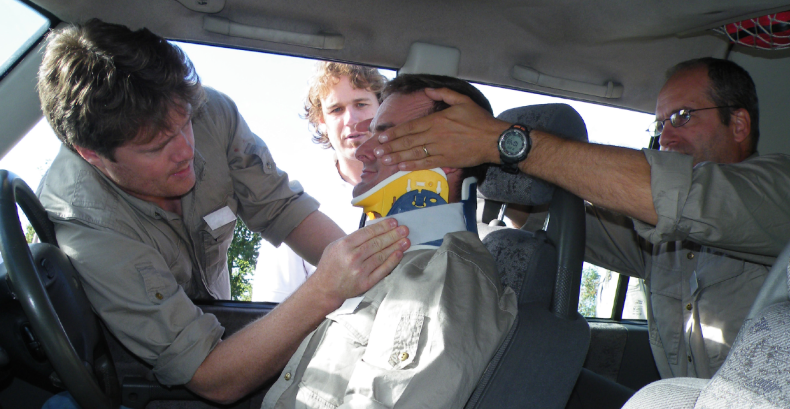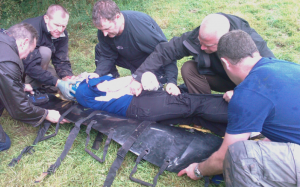Continuing the series of articles on the safe management and treatment of a medical emergency, Prometheus Senior Instructor, Kate Owen, discusses the management of spinal injuries.
Spinal trauma and spinal cord injury can have a life-changing impact for patients following trauma. One cannot reverse prior spinal cord damage, but with even limited training, one can prevent further damage from occurring, which can often be of great benefit for the patient.
It is reported that over 1,200 people in the United Kingdom are paralysed from a spinal cord injury (SCI) every year. The main causes are road traffic collisions (RTCs) or falls causing blunt trauma. The most common group of patients is young males who account for around 50% of SCI patients.
The spinal cord runs within the vertebral column of the spine. It is a network of nerve fibres that control the functions of the body, relaying messages to and from the brain. When the spinal cord becomes damaged these messages are disrupted. This could be complete disruption or partial disruption, but it is unlikely that you will be able to identify what pathways are involved without specialist assistance. For all cases where you suspect a SCI, utmost suspicion and care must be taken.
The cervical spine (C-spine) comprises the top seven vertebrae of the spine in the neck. It is the most vulnerable part of the spine. The head acts as a weight and can be flexed or extended on impact causing disruption to the spinal cord within the C-spine. Over half of spinal injuries occur are at the level of the C-spine.
The primary injury happens at the point of impact. This has already happened when you assess a patient and nothing can change this, but preventing secondary injury is where you can make a difference. The assessment of the patient still follows the <c>ABCDE approach. Within the ‘A’ part, consideration must also be given to a C-spine injury. Airway control with spinal immobilization can protect the C-spine from further movement and thus further damage.
Recognising a potential SCI involves obtaining a good history of prior events and having a high suspicion of spinal injury. It is important to note that the nerves controlling your heart and lungs originate at the level of the c-spine. The patient may show any of the following signs and symptoms:
■ Altered breathing pattern
■ Altered or absent pulses
■ Midline spinal pain or tenderness in the neck or back
■ Midline neck swelling
■ Midline neck deformity
■ Burning pain in arms or legs
■ Pins and needles in arms or legs
■ Reduced sensation to parts of the body
■ Complete paralysis
Midline means anywhere along the spine.
If your patient cannot move any part of their body below the site of injury, then you must assume that there is injury to the spinal cord until proven otherwise.
The ways in which the C-spine can be protected depends on your environment, whether it permissive or hostile, and also whether you have enough resources and appropriate equipment.
The aim is to keep the spine in its normal anatomical position. In reality, the C-spine must be kept aligned, as this part of the spine is highly moveable. During the initial <c>ABCDE primary survey, manual in-line stabilisation (MILS) should take place if you suspect a spinal injury. MILS is where you hold the head in alignment with the spine to prevent further movement and further damage.
Ideally, the patient should be secured to a scoop stretcher with a cervical collar and head blocks to prevent movement during transit. This may not always be possible or practical due to the environment you are in. Care should be taken to prevent secondary cord injury but should not stop you treating life-threatening injuries because you are holding a patient’s head still.
A cervical collar can be applied to limit movement to the patient’s C-spine, but it still allows for some movement. MILS or appropriate immobilisation should complement the cervical collar.
Improvised immobilisation can be sought if the theory is adhered to. The neck must be held in alignment with the spine and immobilisation of the body from head to hips is the minimum. This could be done by using a hardboard, parcel shelf etc with bags
and tape around the patient’s head. Although not perfect, it allows for safe transportation of your patient to the appropriate facility reducing the chance of further spinal cord injury.
In summary, have a high index of suspicion for spinal injury in any trauma patient and if in any doubt, keep the spine immobilized until definitive care.
References
Association of Ambulance Chief Executives. (AACE). (2013). Joint Royal Colleges Ambulance Liaison Committee. UK Ambulance Service Clinical Practice Guidelines. Class Professional Publishing Ltd. Bridgewater.
Nutbeam, T., Boylan, M. (Editors). (2013). ABC of Prehospital Emergency Medicine. Wiley Blackwell. BMJ Books
Spinal injury statistics available from:
www.apparelyzed.com/statistics.html
By: Kate Owen
Kate Owen is one of Prometheus’ Senior Instructors and has over 15 years’ experience working with the UK ambulance service. She currently works as a HEMS Paramedic.




Leave a Reply